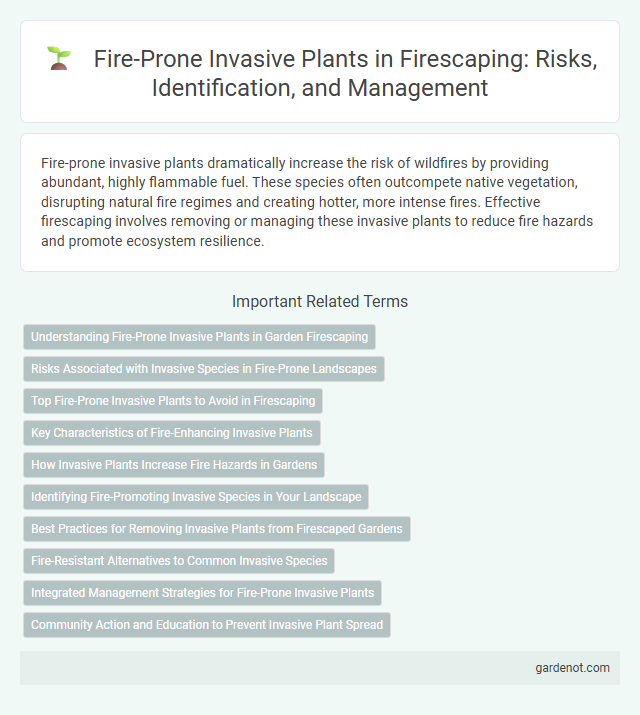Fire-prone invasive plants dramatically increase the risk of wildfires by providing abundant, highly flammable fuel. These species often outcompete native vegetation, disrupting natural fire regimes and creating hotter, more intense fires. Effective firescaping involves removing or managing these invasive plants to reduce fire hazards and promote ecosystem resilience.
Understanding Fire-Prone Invasive Plants in Garden Firescaping
Fire-prone invasive plants such as yellow star-thistle, cheatgrass, and gorse significantly increase wildfire risks due to their high flammability and rapid spread. These species alter natural fire regimes by creating dense, highly combustible fuel loads that can ignite easily and burn intensely. Effective garden firescaping requires identifying and managing these invasive plants to reduce fire hazards and protect surrounding landscapes.
Risks Associated with Invasive Species in Fire-Prone Landscapes
Invasive species in fire-prone landscapes significantly increase the risk of wildfires by altering fuel loads and fire behavior. These plants often create dense, highly flammable biomass that ignites more easily and burns hotter, exacerbating fire intensity and frequency. Managing invasive species is critical to reducing fire hazards and protecting native ecosystems in vulnerable areas.
Top Fire-Prone Invasive Plants to Avoid in Firescaping
Top fire-prone invasive plants to avoid in firescaping include species like cheatgrass, pampas grass, and Himalayan blackberry, which possess high flammability and rapid growth. These plants contribute significantly to fuel loads, increasing wildfire intensity and spread in vulnerable landscapes. Selecting fire-resistant, native vegetation over invasive species is crucial for reducing fire hazards and promoting ecosystem resilience.
Key Characteristics of Fire-Enhancing Invasive Plants
Fire-enhancing invasive plants often possess rapid growth rates, high biomass accumulation, and flammable resin or oils that increase fire intensity and spread. These species typically outcompete native vegetation by altering fuel structure and continuity, creating continuous fine fuels that promote frequent and severe wildfires. Their invasive traits disrupt natural fire regimes, leading to ecosystem degradation and increased fire management challenges.
How Invasive Plants Increase Fire Hazards in Gardens
Invasive plants such as cheatgrass, broom, and privet increase fire hazards in gardens by creating dense, dry vegetation that serves as highly flammable fuel. Their rapid growth and accumulation of dead material elevate fire intensity and spread, overwhelming native plants that typically resist combustion. Managing these species is crucial to reducing fire risk and protecting garden ecosystems.
Identifying Fire-Promoting Invasive Species in Your Landscape
Identifying fire-promoting invasive species like cheatgrass (Bromus tectorum), yellow starthistle (Centaurea solstitialis), and Russian thistle (Salsola tragus) is crucial to reducing wildfire risk in your landscape. These invasive plants have high flammability due to their dry, oily foliage and dense growth patterns, which contribute to rapid fire spread. Regular monitoring and replacement with fire-resistant native species can significantly enhance firescaping efforts and protect property from aggressive wildfires.
Best Practices for Removing Invasive Plants from Firescaped Gardens
Removing fire-prone invasive plants like pampas grass and gorse from firescaped gardens reduces wildfire risk and promotes native biodiversity. Use mechanical removal methods such as cutting and digging out roots followed by targeted herbicide application to prevent regrowth, ensuring compliance with local environmental regulations. Regular monitoring and replanting with fire-resistant native species support long-term fire resilience and ecosystem health.
Fire-Resistant Alternatives to Common Invasive Species
Fire-prone invasive species such as cheatgrass and Brazilian pepper pose significant wildfire risks by increasing fuel loads and fire intensity. Fire-resistant alternatives like manzanita, ceanothus, and mexican sage offer effective landscape solutions due to their low flammability and adaptability to drought conditions. Incorporating these native, fire-safe plants reduces wildfire hazards while supporting ecological balance and biodiversity.
Integrated Management Strategies for Fire-Prone Invasive Plants
Integrated management strategies for fire-prone invasive plants combine mechanical removal, controlled burns, and targeted herbicide application to reduce fuel loads and prevent rapid spread. Employing native plant restoration after invasive species removal enhances ecosystem resilience and minimizes fire risk. Continuous monitoring and adaptive management ensure effective long-term control and habitat recovery, reducing wildfire severity and frequency.
Community Action and Education to Prevent Invasive Plant Spread
Community action plays a crucial role in Firescaping by mobilizing residents to identify and remove fire-prone invasive plants such as cheatgrass and yellow starthistle, which increase wildfire risks. Education programs emphasize the importance of native plant restoration and proper landscaping techniques to reduce fuel loads and promote fire-resistant environments. Collaborative efforts between local governments, environmental organizations, and homeowners foster sustained prevention of invasive plant spread and enhance community resilience to wildfires.
Fire-prone invasive Infographic

 gardenot.com
gardenot.com